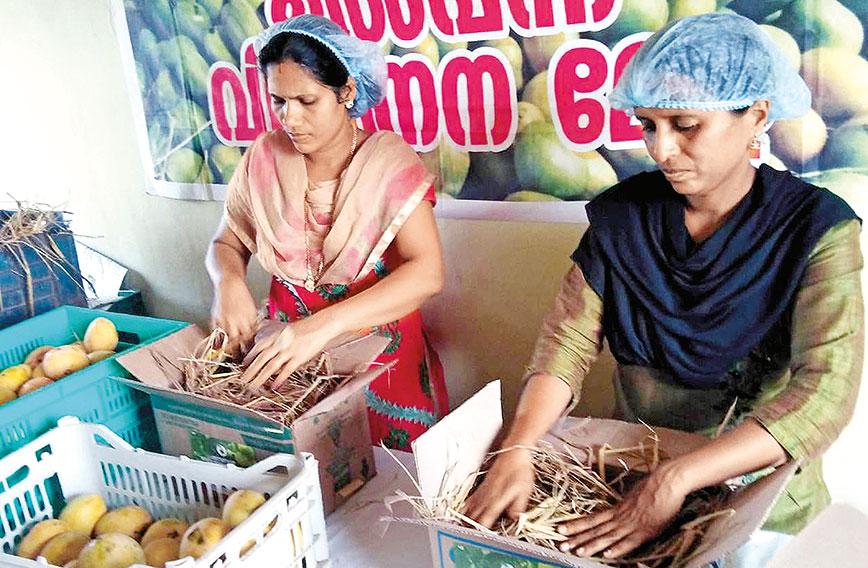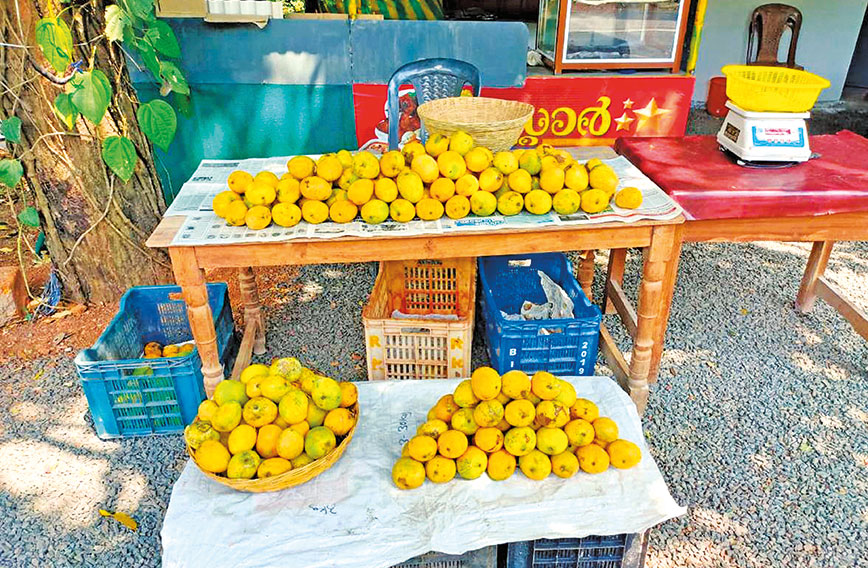
Kuttiattoor Mango Producers’ Company staff packing the fruits in small boxes
Famous mango is a loser in the marketplace
Shree Padre, Kuttiattoor
WHAT ails the Kuttiattoor mango? In the past seven years the stars seemed to shine on this luscious mango. It received a Geographical Indication (GI) tag, thanks to the Kerala Agriculture University’s (KAU) IPR Cell, till recently headed by Dr C.R. Elsy. Media coverage made the Kuttiattoor mango famous throughout Kerala. People began to grow it, making it a household name.
Then, Kannur airport started operations four years ago. The airport is just half an hour’s drive from Kuttiattoor panchayat. In fact, the road to the airport passes through 16 km of Kuttiattoor. Surely that would have made it super easy for the Kuttiattoor mango to find global markets.
Surprisingly, nothing worked. Kuttiattoor’s mango production may boom in one year and bust in the next. It really doesn’t matter. The Kuttiattoor mango is a loser. It doesn’t fetch much of an income to the farmer. It grows in abundance on the tree yet just a minuscule quantity is available for sale.
The mango is the first to arrive in the market. By March, it is ready. That should have given it an edge. Growing tall, each tree produces two to three quintals of fruit. A few trees yield around one tonne of fruit too.
Kuttiattoor panchayat, comprising two villages, Kuttiattoor and Maniyoor, is 16 kilometres from Kannur city in northern Kerala. It is unique in more ways than one. The soil type here in this coastal area is hard laterite. Every household in the two villages has a few mango trees of this variety. The panchayat has over 7,000 households and around 20,000 to 25,000 mango trees. The mango season at Kuttiattoor lasts for a maximum of three months. But why doesn’t it fetch an income to its growers?
ACTION AND REACTION
In June 2015, Civil Society published a story on the unusual Kuttiattoor mango. Immediately, interest levels in Kuttiattoor rose.
The panchayat convened a meeting of scientists and development agencies. It was attended by Dr Dinesh M.R., a mango expert from the Indian Institute of Horticultural Research (IIHR) who subsequently became its director.
“The Kuttiattoor mango is the first to be ready in the season. That itself opens up great marketing opportunities,” said Dr Dinesh.
He reasoned: “If this mango is found suitable for pulping, mango pulp factories can open here about a month in advance. You can also brand the mango and sell it on roadsides by erecting temporary stalls as sales outlets.”
The IIHR team suggested ways to control fruit flies and anthracnose. It also suggested that farmers use low-cost ripening chambers which the institute had developed. The Kannur KVK sent samples to a pulping factory in Karnataka. The factory said it was suitable for pulping. But elections came in the way, bringing such development activities to a standstill. Panchayat elections were followed by Assembly elections and then the general election. There was some talk of convergence between agencies but nothing came of it.
Climate also became a spoiler of sorts. “The cool weather of November-December is crucial for mango yields,” says V.O. Prabhakaran, chairman of Kuttiattoor Mango Producers’ Company Ltd. “If it rains during the mango’s flowering time, the yield drastically reduces. We got a good crop in 2017-18. In the past three years, yields were pretty low. This year, it would be around 30 percent.”
GROWERS’ BLUES
A host of issues plagues harvesting, marketing and selling of the Kuttiattoor mango. Middlemen continue to buy the fruit and sell it in various markets. They pay for the whole tree and get it harvested by an expert climber. The Kuttiattoor mango sells for `100-`120 per kg in Kannur and nearby towns. But the grower gets peanuts. And a major share of the mango remains unharvested, sitting pretty on the tree.
M. Chandran, 69, a resident of Kuttiattoor, has 20 big trees. One of them yields six quintals of fruit. “To harvest only mature fruits, you need to carry out four or five rounds of harvesting. But lately we have been facing a paucity of expert climbers. So, the number of middlemen has also declined. In the past few years mango growers are earning just a 15 to 20 percent increase in prices.”
Jishil K. owns a hotel in the village and has 15 mango trees. He started a sales counter adjacent to his hotel to sell his mangoes directly to interested buyers at `120 a kg in March, and at `80 per kg during the peak season. He began buying from his neighbourhood, paying `1,500 to the climber and `800 to a labourer to catch the fruit that falls from the tree with the help of a gunny bag. He sold 200 kg through a courier to 40 customers. “All my customers were happy. In the process, I learnt a few lessons,” he points out happily.
Climate change is an issue. In the past, the mango used to be ready very early for harvesting. But now seasonal changes are affecting production. “You will find mangoes ripening at various times on the same tree,” says Jishil. “If there is a heavy downpour in summer the fruit gets ruined.”
The Kuttiattoor mango also varies in taste and fibre content depending on which part of the village it is growing. “Trees growing in pockets like Veshala and Pomdarap in Kuttiatoor village get good sunlight. Trees in the fully lateritic belt without any shadow falling on them also yield fruit of good quality and appearance,” says Chandran.
Some farmers now sell their mangoes in makeshift stalls at roadsides. A small value-addition unit producing pickle, squash and jam has also been set up. But it doesn’t make a dent even in the local market.
In 2016, the Kuttiattoor Mango Producers’ Company, a Farmer-Producer Organization (FPO), experimented with selling naturally ripened mangoes directly to customers. The demand was overwhelming. But harvesting and selecting quality fruits proved to be a hurdle. This year the FPO started with new vigour, thanks to a new administrative committee. It opened a stall in Kuttiattoor town to sell mangoes in three- kg carton boxes. This was popular.

A makeshift roadside stall
In April, the CPI(M) organized its 23rd Party Congress in Kannur. Kuttiattoor mangoes were sold at the venue and got some national exposure. As a result, the FPO got a lot of trade enquiries and even hired an expert harvester for better supply. “But we could not harvest so many mangoes and we ended up meeting just a small portion of the demand,” lamented Prabhakaran.
The Kuttiattoor Mango Producers’ Company has tried to boost marketing. It has enlisted 2,000 farmers who have high- yielding trees. Production, if all goes well, is expected to reach 4,000 to 6,000 tonnes. The panchayat has also organized Farmer Interested Groups (FIGs) in each of its 20 wards with the ward member as its convener. The FIG is supposed to arrange harvesting, grading, ripening and supply of Kuttiattoor mangoes. But no progress has been achieved along these lines.
Jayaraj P., head of the Kannur Krishi Vigyan Kendra (KVK), says: “Unfortunately, we don’t have a single mango orchard to show visitors. We plan to raise an orchard in the village itself, using grafts from carefully selected mother trees. We would like to go for a high density model, with well pruned trees from which anyone can easily harvest fruit. This would also serve as a demo orchard which villages can see and emulate.”
Kannur KVK has recently installed a ripening chamber at a farmer’s home for other mango tree owners to consider. The chamber is a do-it-yourself model and costs around `9,000. Mature mangoes are to be kept inside for five days. “The response is very good. We get uniform coloured mangoes. Wastage is also reduced,” say KVK sources. According to Dr Jayaraj P., “Mangoes ripened in the chamber also have a longer shelf life of about a week instead of two or three days.” KVK has proposed setting up 10 ripening chambers in different parts of the panchayat. Currently, locals say contractors artificially ripen the fruit and transport it long distances.
Value addition and fresh fruit sales are two major possibilities for Kuttiattoor to generate an income from its wonderful mangoes. Unfortunately, value addition faces more challenges than prospects.
First, because value addition can be done only during the brief crop season of three months. This means the unit can’t employ regular staff. Secondly, there are any number of companies producing jam, squash and related products. Achieving one- upmanship for Kuttiattoor mango products is not easy. Developing regular trade channels is also out of the question because of limited period of operation. All processing activities are currently being done manually and its output is pretty small.
In comparison, direct fresh fruit marketing is far more promising. If a local group puts in dedicated efforts, branding and online marketing is not a far-fetched dream. If a reliable supply chain is created and the quality of mangoes is ensured, the Kuttiattoor mango can be sold in at least half the state. Besides, the mango has a GI tag.
DO-NOTHING MANGO
“One of the main reasons why the Kuttiattoor mango hasn’t taken off is because it is taken for granted. It is a do-nothing homestead crop like jackfruit. Families don’t see it as a commercial crop or look at it from an agribusiness angle. You need a dedicated campaign to change mindsets,” says Dr Jayraj P. “Take the issue of fruit flies. They can be well controlled with pheromone traps. We had distributed 500 such traps free of cost last year. But people don’t come forward to spend `100 and repeat the process.”
More than half the trees are pretty big. Many old trees have parasitic vanda plants on them, making the Kuttiattoor mangoes an inaccessible wealth. The Bala Saheb Konkan Krishi Vidyapeeth (BSKKV) in Dapoli in Ratnagiri district of Maharashtra faced a similar problem. Their famed Alphonso mango trees grew to a huge height. In a three-year project beginning from 2014, they pruned some 3,500 trees to a manageable height.
“We retained a height of only 12 to 15 feet. It took us three years to get a good crop again,” says Mahesh M. Kulkarni, assistant professor at BSKKV’s department of horticulture. “We have held demonstrations in about 100 villages and put together a team of 4,000 master trainers. You need to spend about `1,500 on each tree. Nearly 35,000 farmers from Karnataka, Maharashtra and Gujarat have come to see this success story.”
Now Kuttiattoor and the Kannur KVK have reached out to BSKKV and an exposure visit to study Dapoli’s mango rejuvenation is being planned. But the question is: will the indifferent mango tree owners of Kuttiattoor respond with enthusiasm? Local groups are determined to make this rejuvenation technology a game changer.
Comments
-

Jawaharlal Henriques - May 24, 2022, 10:28 p.m.
Fair



